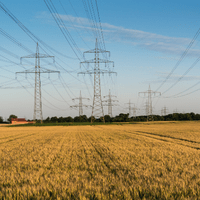Data centers provide essential support to businesses in the modern world. Whether it’s government agencies, health systems, or retailers of all kinds, every business needs a place to store data to function effectively. We sat down with TenHats’ own Wade Orloski to learn how the right data center can boost your ROI and reduce costs.
Choosing an environmentally sustainable data center can help reduce operating costs and provide a higher return on investment. This is because they can be cooled effectively at higher temperatures than most people assume. By focusing on efficiency, you get reliable data storage that costs less, is more efficient, and is more reliable.
Why Does Sustainability Matter Within a Data Center?
Wade: It’s all about cost. We try to use the environment around us to help lower costs. Using alternative sources of power helps lower operating costs which increases ROI for our clients.

PUE (power utilization effectiveness) for data centers refers to the fact that, for every megawatt, it typically takes a megawatt to cool it. Our PUE is around 1.3 megawatts for every megawatt used. It’s a big deal to keep the PUE down since the lower it is, the better the company operates.
Not only does this help us operate better but it also helps us be more sustainable. The lower we keep our PUE, the less energy we use. This helps us put less of an impact on the environment.
Click here to learn more about our data center!
How Is the Industry Trending Towards Sustainability?
Wade: The chillers we use are becoming more prevalent. They use outside air to cool the data center. A lot of places don’t do that and still opt for compressors, although we still have to do that when it’s hot outside. It’s still nice to use the outside air for cooling and only use compressors when absolutely necessary. We also make sure to clean the air before using it to cool the data center.
Some data centers in different areas claim to be sustainable, but a lot of them don’t have access to the varieties of sustainable power that we do in Knoxville, Tennessee. The trend hasn’t spread across the country yet, but it’s starting to catch up and you’re going to start seeing it a lot more. Often, data centers talk about how cheap the power they use is, but it’s important to remember that cheap, traditional electrical power can mean a slower uptime.
Alternative sources of power found in East Tennessee naturally cost less while working faster and better. This ultimately results in a lower operating cost and a lower PUE without sacrificing optimum uptimes.
Another trend rising in popularity are liquid-cooled chillers in data centers. Newer data centers often talk about the PUE of their chillers and liquid-cooled chillers. This is something you will begin to see across data centers everywhere.
To learn about the data center resilience of our data center, click here!
Does Power Usage Efficiency Serve as an Indicator of a Data Center’s Sustainability?
Wade: The big thing signaling sustainability is going to be chillers and how they chill the actual power in the data center. You’ll want to know how efficient they are because, if they’re not efficient, then the cost of operating the data center is going to be higher, which will also increase the cost of using the data center. There’s a higher risk of the data center being over budget and for their chillers to fail.
When it comes to power plants, you have to trust what the data center says and do research on your own to back it up. For example, TVA (Tennessee Valley Authority) has many power plants but sometimes you can’t pinpoint just one since they feed a large grid.
Contact us today to learn more about TenHats’ sources of power!
Have You Seen a Trend in Clients Caring About the Sustainability Practices of Data Centers?
Wade: The PUE and other factors are becoming more prevalent as clients become more educated on data center best practices, but sustainability hasn’t been a major selling point for most clients yet. There’s a learning curve as well to what sustainability looks like for data centers.
Most clients who walk into our data center are shocked when it’s warm. Data centers are often associated with frigid rooms and images of people putting on jackets and coats before walking inside. However, 76 degrees is actually the optimum temperature for our equipment to chill and maintain a lower PUE.
Our data center is kept at 72 degrees, keeping everything cool and providing comfort for our staff and visitors. Keeping a data center too cold actually wastes energy and runs the risk of creating condensation on the equipment.
Other data centers in the Southeast don’t have:
- Hot aisle containment
- Cold aisle containment
- Optimized chillers
Most data centers blast a lot of air into the area just to keep it cooler. Our team members have visited other data centers where it’s 95 degrees outside, but a coat is required to go inside and work on equipment. Using high levels of energy like this isn’t necessary anymore.
What Does TenHats Do Better Than Other Data Centers in Terms of Sustainability and Greater ROI?

Wade: Using outside air to cool the inside coils makes the most sustainable impact at our data center. We don’t put outside air directly into the data center without it being conditioned. Once the air has been chilled, we use it to chill the coils in the system which cools the air inside the data center. There’s a major focus on the chillers and the hot aisle containment being efficient for optimal performance for our clients.
TenHats also doesn’t run our generators over the amount needed. Data centers in California have to report how much they run their generators and the impact they have on the environment.
The state of Tennessee currently doesn’t have to do that, but we also only run our generators when necessary to help save energy and lower customer costs. Many other data centers don’t take these precautions.
Do You Have Any Predictions for the Future of Sustainability in the Data Center Industry?
Wade: Everything is becoming more compact. An average rack of four kilowatts (kW) was a dense rack 10 or 15 years ago. Now they’re looking at HPC (high-performance computing) and these racks can go from up to 200 kW.
A normal air chiller, like we have, won’t cool that—they only chill up to about 17 kW. So the trend is going toward liquid-cooling, which will be chillers kept around the back of the rack. We are going to be installing those at TenHats within the next year. This type of cooling will actually help our PUE go lower from 1.3 to 1.1 or 1.05. We’re very excited to offer these kinds of results to our clients.
Things are also getting denser within a rack. This means that the amount of power you’re putting in a rack is increasing and you have to be able to cool that power. More dense racks can get warm faster and almost act like heaters. The more efficient our data center is, the better we can cool denser racks.
Do you need a data center solution that reduces operations costs and increases ROI? Contact us today to start a conversation!
You can reduce operational costs and improve ROI with an environmentally sustainable data center. They are kept cool at higher temperatures using lower energy levels, which is actually more effective than traditional methods of cooling. This focus on efficiency provides reliable data storage that’s more affordable, efficient, and reliable.
In 2016, TenHats built the region’s first purpose-built colocation data center in over 20 years. Located in Knoxville, TN, our data center can serve any organization in East Tennessee and beyond. With our team’s IT experience, we provide a lot more than simply protected data. When you call us, you talk to a real IT expert. Connect with our team about our data center today!
